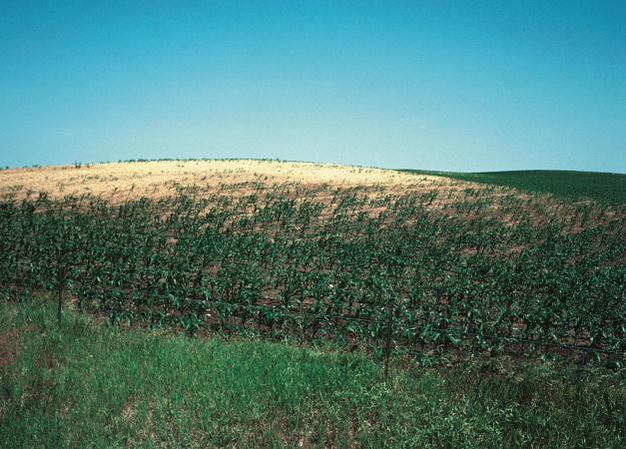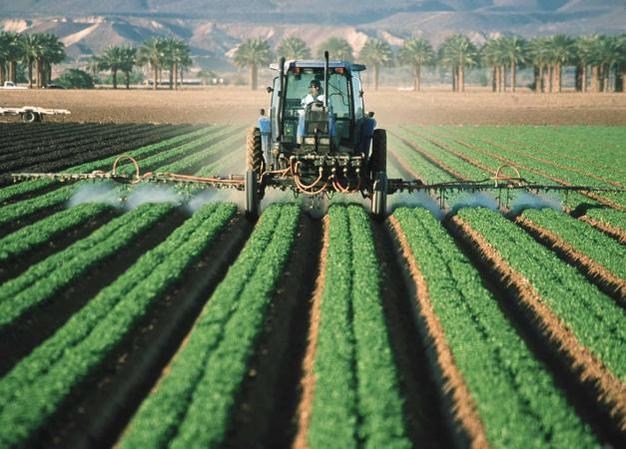« Prev Next »
Introduction
Soils are important for human health in a number of ways. Approximately 78% of the average per capita calorie consumption worldwide comes from crops grown directly in soil, and another nearly 20% comes from terrestrial food sources that rely indirectly on soil (Brevik 2013a). Soils are also a major source of nutrients, and they act as natural filters to remove contaminants from water. However, soils may contain heavy metals, chemicals, or pathogens that have the potential to negatively impact human health. This article will summarize some of the more important and direct relationships between soils and human health.
Quality Food Production and Food Security
Influence of Soils on Crop Yield and Food Security
Food security is achieved when all people have access to sufficient, safe, and nutritious food (Food and Agriculture Organization of the United Nations, 2003). Food security is central to human health (Brevik 2009a; Carvalho 2006), and the ability to produce nutritious crops in sufficient amounts depends on soil properties and conditions. In particular, soils that have well-developed structure, sufficient organic matter, and other physical and chemical properties conducive to promoting crop growth lead to strong yields and are thus important for food security (Reicosky et al. 2011; Brevik 2009b). Soil degradation, which includes soil erosion and loss of soil structure and nutrient content, decreases crop production and threatens food security (Brevik 2013b; Pimentel & Burgess 2013; Lal 2009) (Figure 1). Soils that contain substances such as heavy metals, which may be toxic to humans, can pass those substances on to humans through crop uptake, leading to unsafe foods that compromise food security (Hubert et al. 2010; Brevik 2009a).

Human Nutrient Supply from Soils
A mere 11 elements constitute 99.9% of the atoms in the human body. These are typically divided into major and minor elements. The four major elements, H, O, C, and N, make up approximately 99% of the human body, and seven minor elements, Na, K, Ca, Mg, P, S, and Cl, make up another 0.9% of the body (Combs 2005). Approximately 18 additional elements — called trace elements — are considered essential in small amounts to maintain human life. However, human health experts do not universally agree on the exact number and identity of these trace elements. Out of the approximately 29 elements considered essential for human life, 18 are either essential or beneficial to plants and are obtained from soil, and most of the other elements can be taken up from the soil by plants (Brevik 2013a). The exceptions include H, O, and C, which plants obtain from air and water (Kirkby 2012). Therefore, soils that provide a healthy, nutrient-rich growth medium for plants will result in plant tissues that contain most of the elements required for human life when the plants are consumed (Combs 2005; Committee on Minerals and Toxic Substances in Diets and Water for Animals, National Research Council, 2005).
Negative Health Effects
Heavy Metals
Organic Chemicals
Organic chemicals have been deposited into the soil both naturally and anthropogenically, and many of the organic chemicals deposited into the air and water eventually end up in the soil. Soil contamination with organic chemicals is a serious problem in all nations (Aelion 2009). A large amount of these organic chemicals come from the agricultural application of herbicides, insecticides, and nematicides (Figure 2). Soil pollution with organic chemicals is not limited to farming areas. Soils in urban areas are also polluted with organic chemicals as a result of industrial activities, coal burning, motor vehicle emissions, waste incineration, and sewage and solid waste dumping (Leake et al. 2009). Both farming and urban areas have soil contamination that includes a complex mixture of organic chemicals, metals, and microorganisms caused by municipal and domestic septic system waste, farm animal waste, and other biowastes (Pettry et al. 1973). A more recent health concern includes pharmaceutical waste derived from antibiotics, hormones, and antiparasitic drugs used to treat humans and domestic animals (Albihn 2001).

The most common types of organic chemicals found in soil include polyhalogenated biphenyls, aromatic hydrocarbons, insecticides, herbicides, fossil fuels, and the by-products of fossil fuel combustion (Burgess 2013). These organic chemicals are highly diluted in the upper layers of the soil, and they form chemical mixtures used in reactions involving microorganisms. We have very little toxicological information about the health effects of these chemical mixtures (Carpenter et al. 2002). Studies of the health effects of low concentrations and mixtures of these chemicals in soil have been very limited (Feron et al. 2002). Due to the very long half-lives of many organic chemicals, they are referred to as "persistent organic pollutants." These persistent organic pollutants are organic chemicals that resist decomposition in the environment and bioaccumulate as they move up the food chain. An example of this is 1,1,1-trichloro-2,2-bis(p-chlorophenyl)ethane (DDT), which was shown to disrupt the hormonal systems of raptors (Vega et al. 2007).
Airborne Dust
Soil Pathogens

Water Quality and Soil
Improper sewage sanitation is a problem for approximately 40% of the world's population, and millions of people die each year from water-borne diseases (Massoud et al. 2009). Humans can take advantage of the purifying abilities of soil to address wastewater issues. Well-designed, properly maintained, and functioning on-site sewage treatment systems are highly effective at reducing the risk of water-borne diseases in areas with low population densities (Massoud et al. 2009). Twenty-five percent of the households in the United States use on-site sewage disposal systems, such as septic systems, to deal with their wastewater (Katz et al. 2011). The use of soils to address groundwater contamination issues has been one of the fastest growing areas in soil science research in recent years (Brevik & Hartemink 2010).
References and Recommended Reading
Aelion, C. M. Soil contamination monitoring. In Environmental Monitoring, eds. Inyang, H. I. & Daniels, J. L. (Oxford, England: Encyclopedia of Life Support Systems (EOLSS) Publishers, 2009) Accessed February 5, 2014
Albihn, A. Recycling biowaste-human and animal health problems. Acta Veterinaria Scandinavica 95(Suppl), 69-75 (2001). doi:10.1186/1751-0147-43-S1-S69.
Bartos, T. et al. Which compounds contribute most to elevated airborne exposure and corresponding health risks in the Western Balkans? Environment International 35, 1066-1071 (2009). doi: 10.1016/j.envint.2009.06.005.
Brevik, E. C. Soil, food security, and human health. In Soils, Plant Growth and Crop Production, ed. Verheye, W. (Oxford, England: Encyclopedia of Life Support Systems (EOLSS) Publishers, 2009a). Accessed December 31, 2013
Brevik, E. C. Soil health and productivity. In Soils, Plant Growth and Crop Production, ed. Verheye, W. (Oxford, England: Encyclopedia of Life Support Systems (EOLSS) Publishers, 2009b). Accessed December 31, 2013
Brevik, E. C. Soils and human health: an overview. In Soils and Human Health, eds. Brevik, E. C. & Burgess, L. C. (Boca Raton: CRC Press, 2013a) 29-56.
Brevik, E. C. The potential impact of climate change on soil properties and processes and corresponding influence on food security. Agriculture 3, 398-417 (2013b). doi: 10.3390/agriculture3030398.
Brevik, E. C., & Burgess, L. C. The 2012 fungal meningitis outbreak in the United States: Connections between soils and human health. Soil Horizons 54, (2013). doi:10.2136/sh12-11-0030.
Brevik, E. C. & Burgess, L. C., eds. Soils and Human Health (Boca Raton: CRC Press 2013b).
Brevik, E. C. & Hartemink, A. E. Early Soil knowledge and the birth and development of soil science. Catena 83, 23-33 (2010). doi: 10.1016/j.catena.2010.06.011.
Bultman, M. W., Fisher, F. S., & Pappagianis, D. The ecology of soil-borne human pathogens. In Essentials of Medical Geology, ed. Selinus, O. (Amsterdam: Elsevier, 2005) 481-511.
Burgess, L. C. Organic pollutants in soil. In Soils and Human Health, eds. Brevik, E. C. & Burgess, L. C. (Boca Raton: CRC Press, 2013) 83-106.
Carpenter, D. O., Arcaro, K. F. & Spink, D. C. Understanding the human health effects of chemical mixtures. Environmental Health Perspectives 110(S1), 25-42 (2002).
Carvalho, F. P. Agriculture, pesticides, food security and food safety. Environmental Science & Policy 9, 685-692 (2006). doi: 10.1016/j.envsci.2006.08.002.
Combs Jr, G. F. Geological impacts on nutrition. In Essentials of Medical Geology, eds. Selinus, O. (Amsterdam: Elsevier, 2005) 161-177.
Committee on Minerals and Toxic Substances in Diets and Water for Animals, National Research Council. Mineral Tolerance of Animals, 2nd revised ed. Washington, DC: The National Academies Press, 2005.
Fergusson, J. E. The Heavy Elements: Chemistry, Environmental Impact, and Health Effects, 1st ed. Oxford, England: Pergamon Press, 1990.
Feron, V. J. et al. International issues on human health effects of exposure to chemical mixtures. Environmental Health Perspectives 110(S6), 893-899 (2002).
Food and Agriculture Organization of the United Nations. Trade Reforms and Food Security: Conceptualizing the Linkages. Rome: United Nations (2003).
Garrison, V. H. et al. African and Asian dust: from desert soils to coral reefs. BioScience 53(5), 469-480 (2003). doi: 10.1641/0006-3568(2003)053[0469:AAADFD]2.0.CO;2.
Hamilton, A. J. et al. Wastewater irrigation: the state of play. Vadose Zone Journal 6, 823-840 (2007). doi:10.2136/vzj2007.0026.
Handschumacher, P. & Schwartz, D. Do pedo-epidemiological systems exist? In Soil and Culture, eds. Landa, E. R. & Feller, C. (New York: Springer, 2010) 355-368. doi: 10.1007/978-90-481-2960-7_22.
Helmke, M. F. & Losco, R. L. Soil's influence on water quality and human health. In Soils and Human Health, eds. Brevik, E. C. & Burgess, L. C. (Boca Raton: CRC Press, 2013) 155-176.
Hough, R. L. Soil and human health: an epidemiological review. European Journal of Soil Science 58, 1200-1212 (2007). doi: 10.1111/j.1365-2389.2007.00922.x.
Hu, H. Human health and heavy metals exposure. In Life support: the environment and human health, ed. McCally, M. (Boston: MIT Press, 2002) 65-81.
Hubert, B. et al. The Future of Food: Scenarios for 2050. Crop Science 50, S33-S50 (2010). doi: 10.2135/cropsci2009.09.0530.
Katz, B. G., Eberts, S. M. & Kauffman, L. J. Using Cl/Br ratios and other indicators to assess potential impacts on groundwater quality from septic systems: A review and examples from principal aquifers in the United States. Journal of Hydrology 397, 151-166 (2011). doi: 10.1016/j.jhydrol.2010.11.017.
Kirkby, E. Introduction, definition, and classification of nutrients. In Marschner's Mineral Nutrition of Higher Plants, ed. Marschner, P. (Waltham: Elsevier, 2012) 3-5.
Lal, R. Soil degradation as a reason for inadequate human nutrition. Food Security 1, 45-57 (2009). doi: 10.1007/s12571-009-0009-z.
Leake, J.R. Adam-Bradford, A. & Rigby, J. E. Health benefits of ‘grow your own food' in urban areas: implications for contaminated land risk assessment and risk management. Environmental Health 8(S1), 1-6 (2009). doi: 10.1186/1476-069X-8-S1-S6.
Massoud, M.A., Tarhini, A. & Nasr, J. A. Decentralized approaches to wastewater treatment and management: Applicability in developing countries. Journal of Environmental Management 90, 652-659 (2009). doi: 10.1016/j.jenvman.2008.07.001.
Monteil, M. A. Saharan dust clouds and human health in the English-speaking Caribbean: What we know and don't know. Environmental Geochemistry and Health 30(4), 339-343 (2008). doi: 0.1007/s10653-008-9162-0.
Pepper, I. L. et al. Soil: a public health threat or savior? Critical Reviews in Environmental Science and Technology 39, 416-432 (2009). doi: 10.1080/10643380701664748.
Pettry, D. E. et al. Soil pollution and environmental health. Health Services Reports 88(4), 323-327 (1973).
Pimentel, D. & Burgess, M. Soil erosion threatens food production. Agriculture 3, 443-463 (2013). doi: 10.3390/agriculture3030443.
Reicosky, D. C., Sauer, T. J. & Hatfield, J. L. Challenging balance between productivity and environmental quality: Tillage impacts. In Soil Management: Building a Stable Base for Agriculture, eds. Hatfield, J. L. & Sauer, T. J. (Madison: Soil Science Society of America, 2011) 13-37. doi: 10.2136/2011soilmanagement.c2.
Robinson, B. H. E-waste: an assessment of global production and environmental impacts. Science of the Total Environment 408, 183-191 (2009). doi: 10.1016/j.scitotenv.2009.09.044.
Selinus, O. ed. Essentials of Medical Geology. (New York: Springer, 2013).
Senesi, G. S. et al. Trace element inputs into soils by anthropogenic activities and implications for human health. Chemosphere 39(2), 343-377 (1999). doi: 10.1016/S0045-6535(99)00115-0.
Vega, F.A., Covelo, E.F. & Andrade, M. L. Accidental organochlorine pesticide contamination of soil in Porrino, Spain. Journal of Environmental Quality 36(1), 272-279 (2007). doi: 10.2134/jeq2006.0053.
Walsh, L. M., Sumner, M. E. & Keeney, D. R. Occurrence and distribution of arsenic in soils and plants. Environmental Health Perspectives 19, 67-71 (1977).































